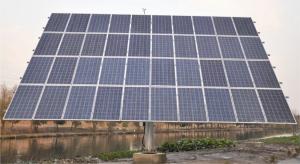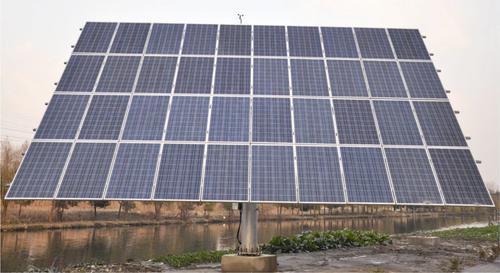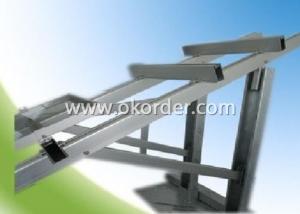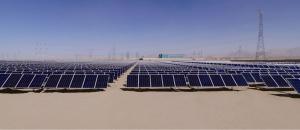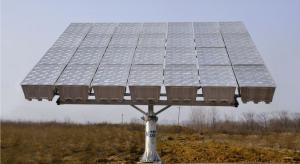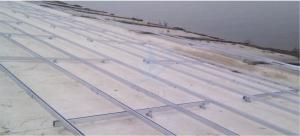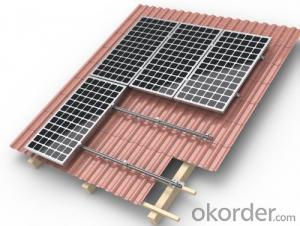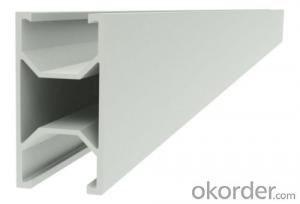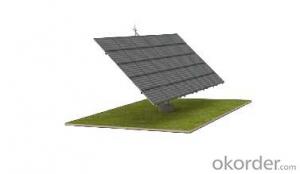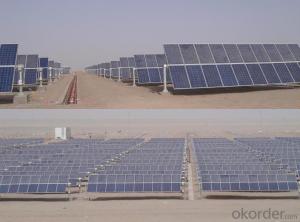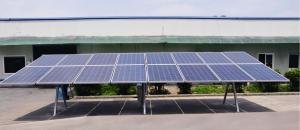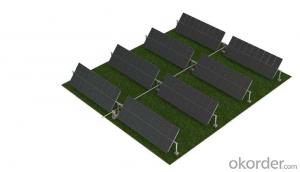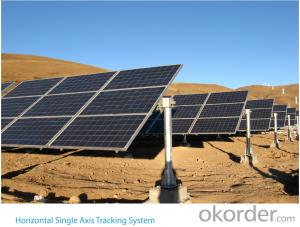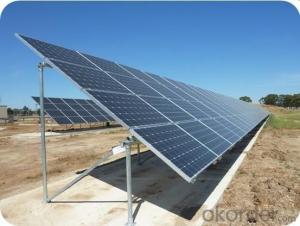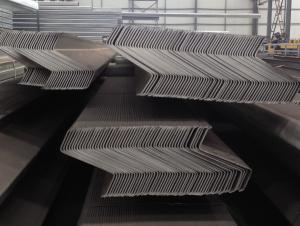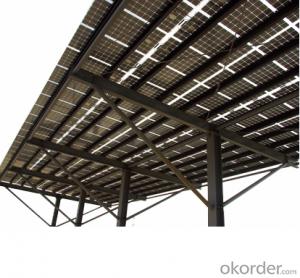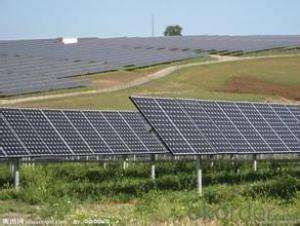S-Rack Solar Mounting Systems for Polycrystalline Dual-Axis Tracking
- Loading Port:
- Shanghai
- Payment Terms:
- TT OR LC
- Min Order Qty:
- 100000 watt
- Supply Capability:
- 5000000 watt/month
OKorder Service Pledge
OKorder Financial Service
You Might Also Like
Products introduction:
Polycrystalline dual-axis tracking system is high-tech petented product.
Y-axis adopt eccentric driving.power generating can be increased more then 40%.
The tracker bracket adopt hot-dipped galvanizde high-quality structual steel Q235B,system stability is very high and maintenance cost is very low,working time more than 25years.
Features:
1. The system, which uses an isosceles triangle bracket as bracket structure and maintenance-free, wind and sand-proof high polymer material bearing moving parts and unique linkage structure, features reliable system stability, low cost and low failure rates.
2. Compared with traditional fixed-bracket its annual energy output can be increased up to approximately 20 percent - 30 percent.
3. With exactly the same or even lower cost as fixed-bracket the system is the optimal choice for the establishment of large and medium-sized high-efficiency solar power stations.
Specification:
• Installed capacity | • 2KW—20KW |
• control method | • light control • time control • light/time control |
• Tracking accuracy | • ≤0.1° |
• Track elevation | • 0—75° |
• Tracking azimuth | • 245° |
• The safe operation of wind speed • | • 75km/h |
• Maximum wind resistance | • 150km/h |
• Drive type | • Rotary gear drive |
• Driving motor power | • DC24V/30W—100W |
• Structural materials | • Q235 Hot dip galvanized steel |
• Protection grade • | • I P 6 5 |
• Service / warranty • | • 25Y/2Y |
• Working environment temperature | • -35℃—65℃ |
• Net area | • 10㎡—120㎡ |
•The weight of the system | • 500kg—3000kg |
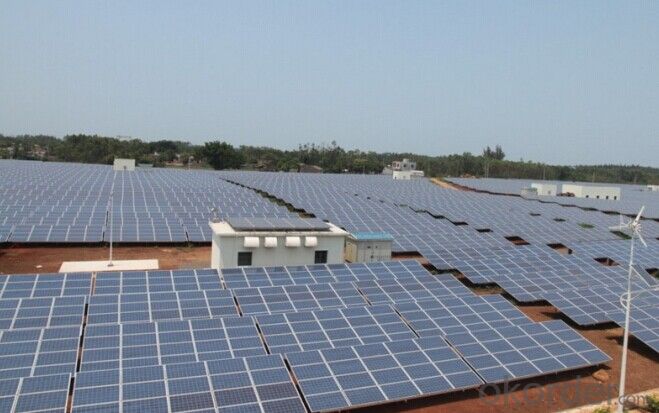
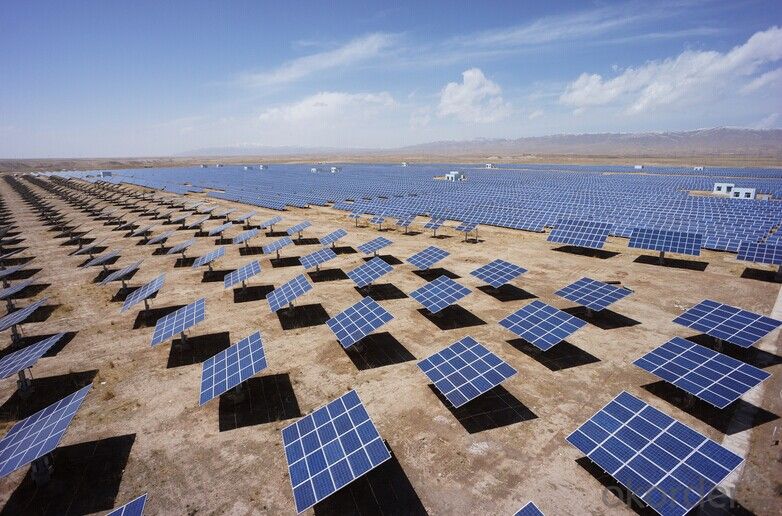
- Q: What is the difference between a roof-mounted and ground-mounted solar system?
- A roof-mounted solar system is installed on the roof of a building, while a ground-mounted solar system is installed on the ground. The main difference lies in their respective locations, with roof-mounted systems utilizing available roof space and ground-mounted systems requiring open land. Roof-mounted systems are generally more common in residential settings, while ground-mounted systems are often used in larger-scale commercial or utility projects.
- Q: Can a solar mounting system be used for solar awnings or sunshades?
- Yes, a solar mounting system can be used for solar awnings or sunshades. These systems are designed to securely hold solar panels in place, and can easily be adapted for use with awnings or sunshades by attaching the solar panels to the structure. This allows for the generation of renewable energy while providing shade or protection from the sun.
- Q: Can a solar mounting system be used in areas with high wind speeds?
- Yes, a solar mounting system can be used in areas with high wind speeds. However, it is important to ensure that the mounting system is specifically designed and engineered to withstand these conditions. This may include features such as stronger brackets, reinforced frames, and secure anchoring methods to ensure the stability and durability of the system in high wind environments.
- Q: Are there any specific requirements for installing a solar mounting system on a floating platform?
- Yes, there are specific requirements for installing a solar mounting system on a floating platform. These requirements include ensuring the platform is stable and can support the weight of the solar panels, selecting appropriate anchoring systems to secure the platform in place, and designing a mounting system that can withstand water and weather conditions. Additionally, electrical safety considerations and proper maintenance procedures should be followed for a successful installation.
- Q: Are there any specific requirements for pergola or shade structure design when using a solar mounting system?
- Yes, there are specific requirements for pergola or shade structure design when using a solar mounting system. The design should allow for proper orientation and tilt of the solar panels to maximize sunlight exposure and energy generation. Additionally, the structure should be sturdy enough to support the weight of the solar panels and withstand wind and snow loads. It is also important to ensure proper spacing between panels and sufficient ventilation to prevent overheating.
- Q: Can a solar mounting system be used on RVs?
- Yes, a solar mounting system can be used on RVs. It allows RV owners to install solar panels on the roof or any available space to generate electricity and power various appliances while on the move. This helps to reduce reliance on traditional power sources and provides an environmentally friendly solution for energy needs while traveling.
- Q: Can a solar mounting system be installed on a rooftop with a hip roof?
- Yes, a solar mounting system can be installed on a rooftop with a hip roof. Hip roofs have sloping sides and a ridge at the top, which can accommodate the installation of solar panels. However, the design and installation process may be slightly more complex compared to a standard flat or gable roof. It is recommended to consult with a professional solar installer to ensure proper installation and compatibility with a hip roof.
- Q: Are there any specific requirements for installing a solar mounting system on a rooftop with rooftop signs or billboards?
- Yes, there are specific requirements for installing a solar mounting system on a rooftop with rooftop signs or billboards. These requirements typically involve assessing the structural integrity of the rooftop, ensuring compatibility between the solar mounting system and the existing rooftop signs or billboards, and obtaining any necessary permits or approvals from local authorities. It is important to consult with a professional solar installer or engineer to ensure compliance with these requirements and to ensure the safe and efficient installation of the solar mounting system.
- Q: Can a solar mounting system be installed on a military or defense facility?
- Yes, a solar mounting system can be installed on a military or defense facility. In fact, many military and defense facilities have embraced solar energy as a sustainable and cost-effective solution for their power needs. Solar mounting systems can be customized to meet the specific requirements and security measures of these facilities, allowing them to reduce their reliance on traditional energy sources and enhance their overall energy resilience.
- Q: Can a solar mounting system be used for solar skylights or atriums?
- Yes, a solar mounting system can be used for solar skylights or atriums. The mounting system provides the necessary support and stability for installing solar panels on the roof or walls of skylights and atriums, allowing them to harness solar energy efficiently.
Send your message to us
S-Rack Solar Mounting Systems for Polycrystalline Dual-Axis Tracking
- Loading Port:
- Shanghai
- Payment Terms:
- TT OR LC
- Min Order Qty:
- 100000 watt
- Supply Capability:
- 5000000 watt/month
OKorder Service Pledge
OKorder Financial Service
Similar products
Hot products
Hot Searches
Related keywords
